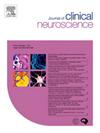A systematic review and meta-analysis on the impact of early vs. delayed pharmacological thromboprophylaxis in patients with traumatic brain injury
IF 1.9
4区 医学
Q3 CLINICAL NEUROLOGY
引用次数: 0
Abstract
Background
Traumatic brain injury (TBI) poses significant health challenges, often leading to complications such as venous thromboembolism (VTE) and increased mortality rates. The administration of early post-traumatic prophylaxis (PTP) is intended to mitigate these risks and enhance overall patient recovery. This study aims to perform a systematic review and meta-analysis assessing clinical outcomes associated with early versus late pharmacologic thromboprophylaxis in TBI patients.
Methods
We conducted a literature search across PubMed and Scopus databases from their inception to March 2024. Data from eligible studies were aggregated using the generic inverse variance method, with outcomes reported as odds ratios (OR).
Results
The review encompassed 20 studies involving 87,726 patients. Early PTP was categorized based on the timing of administration: 1) within 24 h, 2) within 48 h, and 3) within 72 h of hospital admission. Our findings indicated that early prophylaxis significantly reduced the incidence of VTE, deep vein thrombosis (DVT), pulmonary embolism (PE), and overall mortality when compared to late administration. Specifically, early PTP was associated with a markedly lower risk of VTE (OR: 0.38; 95 % CI: 0.30 to 0.48; P < 0.00001), DVT (OR: 0.32; 95 % CI: 0.25 to 0.41; P < 0.00001), and PE (OR: 0.39; 95 % CI: 0.31 to 0.49; P < 0.00001). Furthermore, the analysis revealed a significant reduction in all-cause mortality within the early PTP group (OR: 0.71; 95 % CI: 0.53 to 0.97; P = 0.03). However, while statistically significant improvements were observed in the <48-hour subgroup, neither the <24-hour nor <72-hour groups achieved statistical significance.
Conclusion
These robust findings highlight the potential of early pharmacologic thromboprophylaxis as a crucial intervention to enhance patient outcomes following traumatic brain injuries.
创伤性脑损伤患者早期与延迟药物血栓预防影响的系统回顾和荟萃分析。
背景:外伤性脑损伤(TBI)带来了重大的健康挑战,往往导致并发症,如静脉血栓栓塞(VTE)和死亡率增加。早期创伤后预防(PTP)的管理旨在减轻这些风险,提高患者的整体康复。本研究旨在进行系统回顾和荟萃分析,评估TBI患者早期和晚期药物血栓预防相关的临床结果。方法:我们对PubMed和Scopus数据库进行了从建立到2024年3月的文献检索。采用通用反方差法对符合条件的研究数据进行汇总,结果以比值比(OR)报告。结果:该综述包括20项研究,涉及87,726例患者。早期PTP根据给药时间进行分类:1)入院后24小时内,2)入院后48小时内,3)入院后72小时内。我们的研究结果表明,与晚期给药相比,早期预防显著降低了静脉血栓形成(VTE)、深静脉血栓形成(DVT)、肺栓塞(PE)的发生率和总死亡率。具体而言,早期PTP与VTE风险显著降低相关(OR: 0.38;95% CI: 0.30 ~ 0.48;结论:这些强有力的发现强调了早期药物血栓预防的潜力,作为一种重要的干预措施,以提高创伤性脑损伤后患者的预后。
本文章由计算机程序翻译,如有差异,请以英文原文为准。
求助全文
约1分钟内获得全文
求助全文
来源期刊

Journal of Clinical Neuroscience
医学-临床神经学
CiteScore
4.50
自引率
0.00%
发文量
402
审稿时长
40 days
期刊介绍:
This International journal, Journal of Clinical Neuroscience, publishes articles on clinical neurosurgery and neurology and the related neurosciences such as neuro-pathology, neuro-radiology, neuro-ophthalmology and neuro-physiology.
The journal has a broad International perspective, and emphasises the advances occurring in Asia, the Pacific Rim region, Europe and North America. The Journal acts as a focus for publication of major clinical and laboratory research, as well as publishing solicited manuscripts on specific subjects from experts, case reports and other information of interest to clinicians working in the clinical neurosciences.
 求助内容:
求助内容: 应助结果提醒方式:
应助结果提醒方式:


